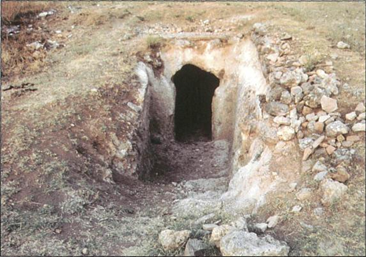Investigations in the vicinity of the palace of nestor

Figure 36. Entrance passage and door of southernmost chamber tomb at Volimidia
Chora The town of Chora is strategically situated at the junction of the ridge of Englianos and the expanse of flatter tableland that sits at the foot of Mount Aigaleon. It commands the only convenient routes leading north, south, or east from the Palace of Nestor. The earliest traces of occupation at Chora (4th millennium B.C.) were found by Marinatos in a cave called Katavothra not far south of the town square. Mycenaean remains are concentrated in the suburb known as Volimidia, along the asphalt road that leads ultimately to the village of Vlachopoulo. In 1953 Marinatos found occupation deposits contemporary with the Palace of Nestor and from Early Mycenaean times. He suspected that there had been a prosperous Mycenaean town at Voli¬midia. No true tholos tombs were ever built there. The site is best known for large chamber tombs, a third of them built already in the 16th century B.C. (Fig. 36). Many were reused in historical times.24
Myrsinochori The village of Myrsinochori is separated by a deep gorge from the uplands around Chora. Northeast of the village an earthen track leads along the ridge of Routsi
to the village of Metamorphosis. No Mycenaean settlement has yet been found here, but two Early Mycenaean tholos tombs were discovered and excavated by Marinatos.25 Both tombs were built long before the Palace of Nestor and had gone out of use by the 13th century B.C. Many of the lux¬ury ornaments that adorned the burials have close parallels in the wealthy Shaft Graves at Mycenae of similar date, and one grave was exceptionally rich in amber beads. Other finds included bronze swords and daggers, vessels of pre¬cious metal, objects of ivory, and sealstones.
About a kilometer northeast of the Virgin of Routsi church, a team from the University of Athens under the direction of George Korres recently excavated a mound of stone and earth containing a large box-shaped grave con¬structed of stone slabs. Several burials were deposited in large storage jars along the periphery of the mound, with their mouths framed by stone slabs so as to form a threshold and lintel with door jambs. It has been suggested that the first tholos tombs monumentalized in stone this earlier form of interment.
(JLD)